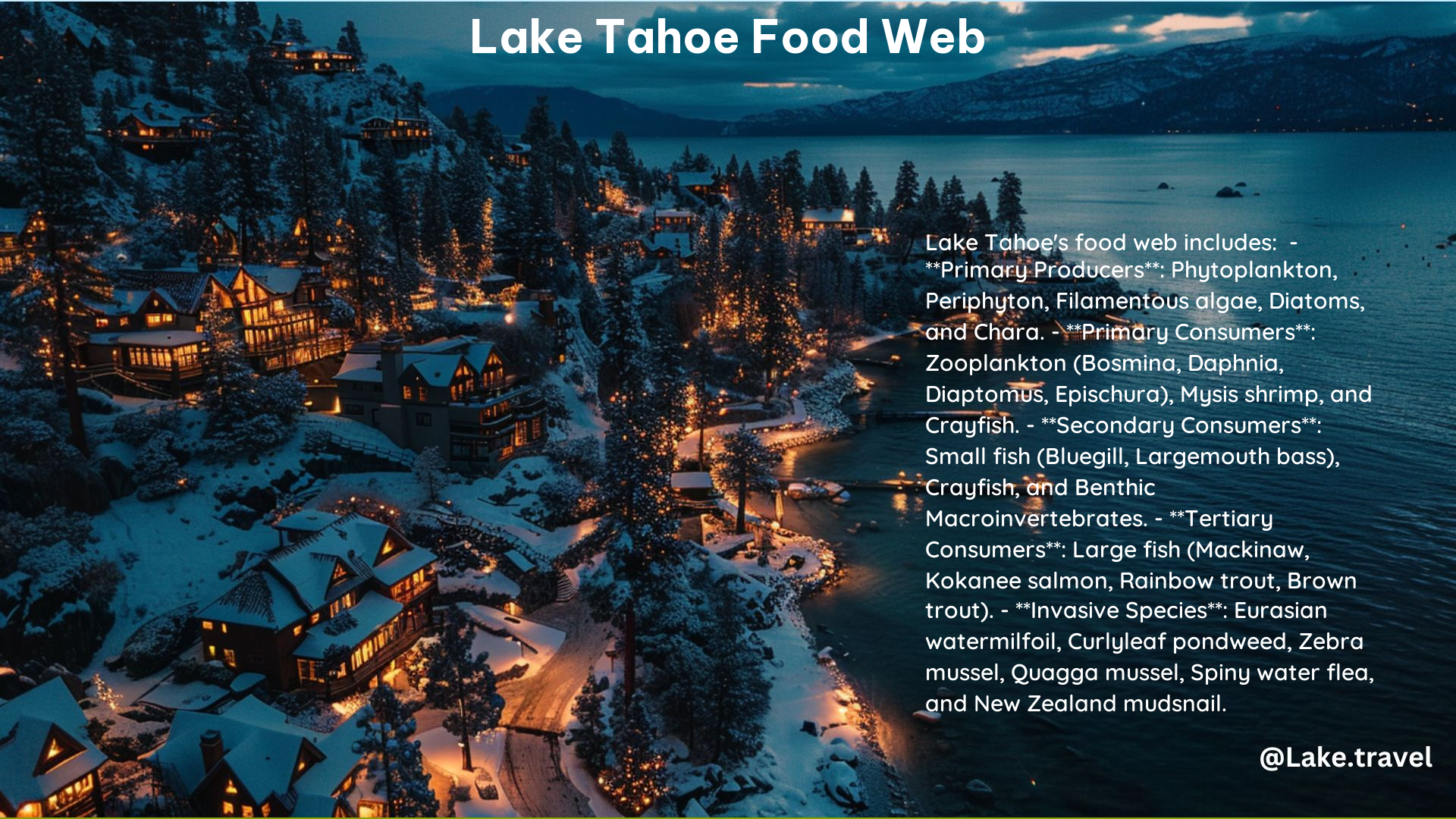Lake Tahoe’s food web is a intricate network of interactions between various species that inhabit the lake and its surrounding ecosystem. This delicate balance is crucial for maintaining the health and sustainability of the lake’s unique environment. In this blog post, we’ll dive deep into the key components of the Lake Tahoe food web, explore the changes and challenges it faces, and understand the ongoing efforts to monitor and research this vital ecosystem.
Native Species: The Foundation of the Lake Tahoe Food Web
At the base of the Lake Tahoe food web are the phytoplankton, tiny plants that harness the power of photosynthesis to provide energy for the entire ecosystem. These microscopic organisms are the primary producers, forming the foundation upon which the rest of the food web is built.
Feeding on the phytoplankton are the zooplankton, small animals such as Bosmina, Daphnia, Diaptomus, and Epischura. These tiny creatures play a crucial role in transferring the energy from the phytoplankton to the higher trophic levels.
The native fish species of Lake Tahoe, including the Tahoe sucker, Lahontan redside, Paiute sculpin, Speckled dace, and Mountain whitefish, are important consumers in the food web. These fish rely on the zooplankton and other aquatic organisms as their primary food sources.
Invertebrates, such as the Asian clam, crayfish, and benthic macroinvertebrates, also play significant roles in the Lake Tahoe food web, contributing to the overall diversity and balance of the ecosystem.
Non-Native Species: Disrupting the Delicate Balance

The introduction of non-native species has had a significant impact on the Lake Tahoe food web. One of the most notable examples is the Mysis shrimp, which was intentionally introduced to the lake decades ago. These shrimp have had a profound effect on the native zooplankton populations, altering the dynamics of the food web.
Another invasive species is the goldfish, which has been intentionally introduced and has contributed to changes in the food web. Additionally, the presence of other non-native species, such as zebra mussels, quagga mussels, spiny water fleas, and New Zealand mudsnails, pose ongoing threats to the native ecosystem.
Changes in the Food Web: Challenges and Adaptations
The Lake Tahoe food web has experienced several notable changes in recent years. One significant development is the decline of Mysis shrimp, which could have cascading effects on the rest of the food web. This shift in the population dynamics of a key species can have far-reaching implications for the entire ecosystem.
Another concern is the occurrence of algal blooms, particularly in the nearshore areas of Lake Tahoe. These extensive blooms can alter the composition of phytoplankton, potentially disrupting the delicate balance of the food web.
The presence of microplastics in the lake is also a growing concern, as these tiny particles can be ingested by various organisms and potentially harm them, with unknown long-term consequences for the food web.
Monitoring and Research Efforts: Safeguarding the Lake Tahoe Ecosystem
The Tahoe Environmental Research Center (TERC) at the University of California, Davis, has been continuously monitoring the lake since 1968, providing invaluable insights into the changes in the Lake Tahoe food web. The annual “Tahoe: State of the Lake” report offers detailed updates on the lake’s health and the impacts of various factors on the food web.
Additionally, educational programs like the “VFT Aquatic Food Web” allow students and the public to explore and understand the changes in the Lake Tahoe food web through interactive virtual field trips and activities.
These ongoing monitoring and research efforts are crucial for understanding the complex dynamics of the Lake Tahoe food web and developing strategies to protect and preserve this iconic alpine lake for generations to come.
Conclusion
The Lake Tahoe food web is a intricate and delicate system that is essential for the overall health and balance of the lake’s ecosystem. By understanding the native species, the impacts of non-native introductions, and the ongoing changes and challenges, we can better appreciate the importance of this complex network of interactions. Through continued monitoring, research, and collaborative efforts, we can work to safeguard the Lake Tahoe food web and ensure the long-term sustainability of this remarkable natural wonder.
References:
- https://yubanet.com/regional/clarity-changing-food-web-detailed-in-annual-lake-tahoe-report/
- https://prezi.com/p/qkk5fewnodby/lake-tahoe-food-web/
- https://tahoe.ucdavis.edu/sites/g/files/dgvnsk4286/files/inline-files/currentfoodweb_v2.pdf
- https://tahoe.ucdavis.edu/vft-aquatic-food-web
- https://prezi.com/p/8qb4smlw7rte/lake-tahoes-food-web/
